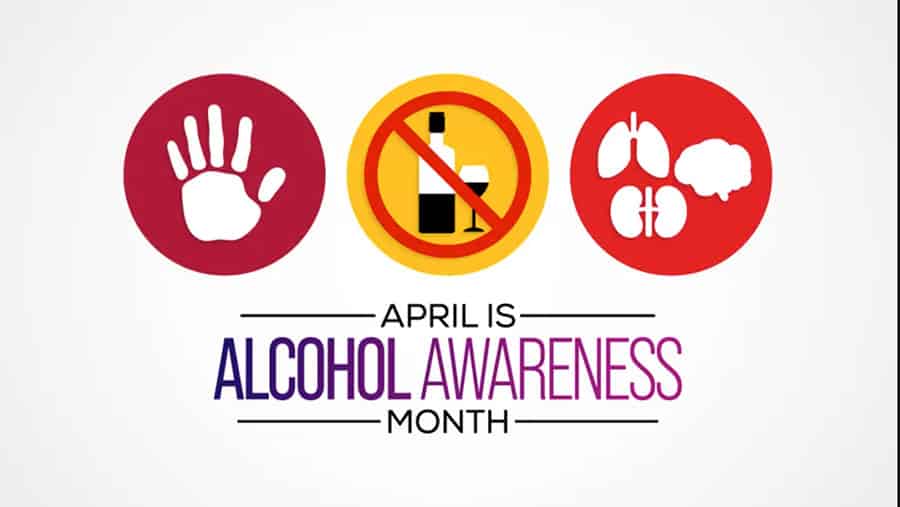Alcohol Awareness Month 2021: What it is & Why it Matters
Alcohol Awareness Month is sponsored by the National Council on Alcoholism and Drug Dependence (NCADD) and occurs in April of each year. By sponsoring Alcohol Awareness Month, the NCADD aims to increase awareness of the dangers of alcohol use – especially excessive alcohol use, and highlight the dangers of alcohol use in any quantity.
The Purpose of Alcohol Awareness Month
Alcohol awareness month serves to help people become more aware of the dangers of alcohol abuse and de-stigmatize the disease of addiction. It also aims to educate all people on how alcohol use in any form can affect your health and challenge peoples’ relationship that they have with this drug.
Although alcohol is a widely-accepted drug of use in the United States and various other cultures and countries across the world, alcohol is still a drug that wreaks immense havoc on our population.

Alcohol Use Disorders and Alcoholism
According to the National Institute on Alcohol Abuse and Alcoholism, alcohol use disorders are characterized by “an impaired ability to stop or control alcohol use despite adverse social, occupational, or health consequences.”1 The term “alcohol use disorder” refers to what some people call alcoholism, alcohol abuse, and other similar terms.
How to Participate in Alcohol Awareness Month 2021
If you’d like to help support the cause of Alcohol Awareness Month in April of 2021, here are some tips:
- Participate in alcohol awareness campaigns at your school, job, or social club.
- Read more about alcohol abuse in the United States and the harm it is doing to our nation.
- If you have a child, you can play a vital role in helping educate your children on the dangers of any form of alcohol use.
- Try refraining from drinking for three days or one week to re-evaluate your relationship with alcohol. (However, if you believe that you may be physically addicted to alcohol, do NOT attempt to stop drinking on your own. Instead, reach out to a reputable detox center in your area that can help you determine whether or not you may need medical help while detoxing from booze).
- Educate yourself on alcohol-related policies in the United States and how you can support the enforcement or creation of these policies.
- Work to, on a daily basis, change the societal perception of alcohol use disorders by reminding those around you that alcoholism/alcohol abuse IS a chronic medical condition.
- Find out more about your local alcohol treatment centers and rehab centers for alcohol abuse near you.
Statistics on Alcoholism and Alcohol Abuse
- In 2019, over 25% of people ages 18 and over reported engaging in binge drinking in the past month.2
- When someone engages in high-intensity drinking (in other words, when someone consumes more alcohol than their gender-specific binge drinking threshold as set forth by the Centers for Disease Control and Prevention), may result in someone being 70 times more likely to have an alcohol-related emergency department (ED) visit.2
- The amount of alcohol-related ED visits increased 47 percent between 2006 and 2014.
- Alcohol contributes to over 22% of overdose deaths that also involve opioid drugs, meaning that alcohol use can be a deadly counterpart to opioid use.2
- An estimated 95,000 people die from alcohol-related causes yearly, making alcohol use the 3rd most deadly preventable cause of death in the United States.2
Reach out to Hotel California by the Sea
We specialize in treating addiction and other co-occurring disorders, such as PTSD. Our Admissions specialists are available to walk you through the best options for treating your addiction.
Statistics on Underage Alcohol Use
Underage drinking may be especially harmful to people’s developing brains. Some facts and figures regarding underage drinking include the following:1,2
- 4.2 million people (Over 10% of people) ages 12 through 20 reported binge drinking within the past month according to the NSDUH.
- Underage drinking can also contribute to a variety of ancillary consequences, including sexual assault, injuries, overdoses, and more.
- Luckily, a decline has been seen in underage drinking in recent times, but there is still much work to do in decreasing underage alcohol use and abuse in the United States.
- According to one study, those aged 26 and over who began drinking before they turned 15 were 5 times more likely to report having an alcohol use disorder.
Treating AUDs and other Substance Use Disorders in the United States
There are thousands of facilities, individual therapists, support groups, and other means of getting help for an alcohol use disorder in the United States.
If you or your loved one are looking to attend rehab in the US, be sure to contact Hotel California by the Sea. Our rehab center boasts locations in California, Washington, Missouri, and Ohio and accepts multiple forms of private health insurance. Each of our locations also offers multiple levels of care that vary in intensity, as well as a wide variety of behavioral and medication-based therapies.
We are here to help you or your loved one reclaim your life and begin healing from unhealthy alcohol use. Call us today to speak to one of our friendly addiction treatment representatives who can help you understand your best course of action moving forward, as well as show you how, where, and when to get help for you or your loved one’s alcohol abuse issues. If you’d like, we can also help you understand your behavioral health insurance benefits and whether or not your treatment may be completely free, or at least partially-covered, at Hotel California by the Sea.

Check Your Insurance Coverage for FREE
Find out if your insurance covers addiction treatment in minutes. We accept most insurance!
Sources:
- https://www.niaaa.nih.gov/publications/brochures-and-fact-sheets/understanding-alcohol-use-disorder
- https://www.samhsa.gov/data/sites/default/files/reports/rpt29394/NSDUHDetailedTabs2019/NSDUHDetTabsSect2pe2019.htm#tab2-20b
- https://www.niaaa.nih.gov/publications/brochures-and-fact-sheets/alcohol-facts-and-statistics
